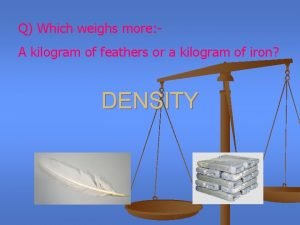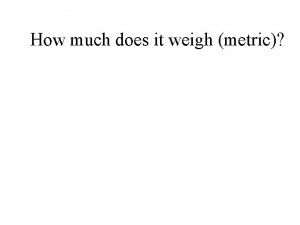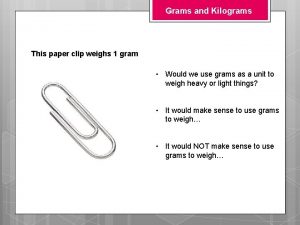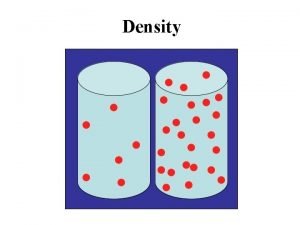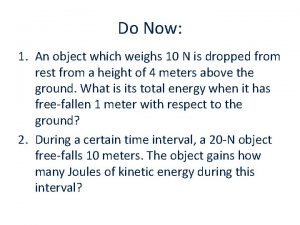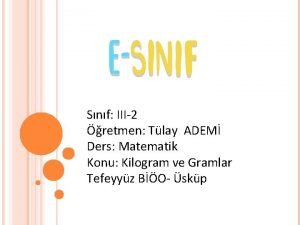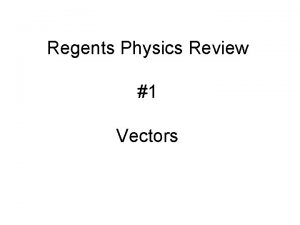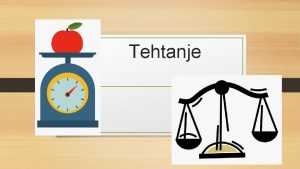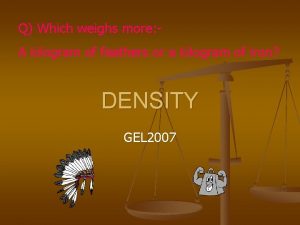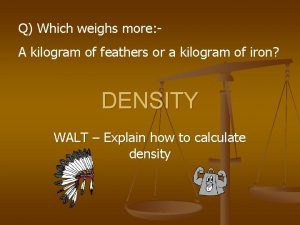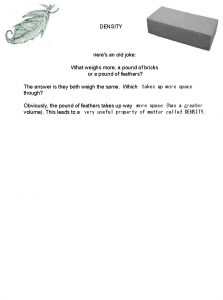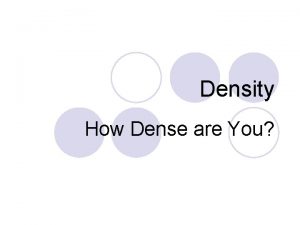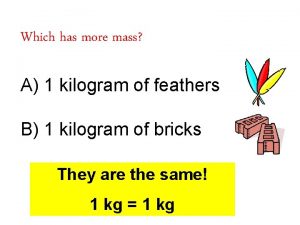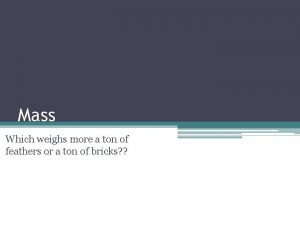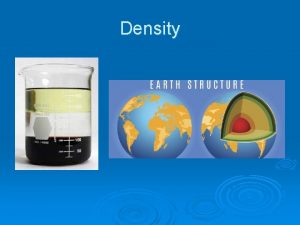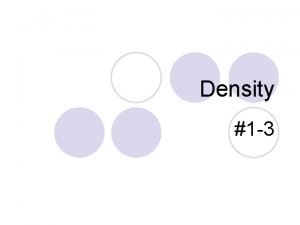Density Q Which weighs more A kilogram of

















- Slides: 17

Density

Q) Which weighs more: A kilogram of feathers or a kilogram of iron? DENSITY Objective: To describe how to determine density using direct measurements of mass and volume

What is Density? If you take the same volume of different substances, then they will weigh different amounts. 1 Wood Water cm 3 0. 50 g 1 1. 00 g Iron 1 cm 3 = 1 ml 8. 00 g Q) Which has the greatest mass and therefore the most dense? Density is the Mass per unit Volume

Density Equation: g or kg Density = g/cm 3 or kg/m 3 = m V V=m m= x. V Mass Volume cm 3 or m 3 (or ml) Example: Q) You have 250 g of water with a volume of 250 cm 3 Calculate the density of water? A) water = m = 250 = 1 g/cm 3 V 250

DENSITY OF A REGULAR SOLID m = 240 g 2. 0 cm 3. 0 cm 4. 0 cm • Find the Mass of the solid on a balance (scales). • Measure three lengths and calculate the Volume. (ie V = l x w x h ) • Calculate the Density. = m = 240 =10. 0 g/cm 3 V 24

DENSITY OF AN IRREGULAR SOLID • Find the Mass of the solid on a balance. • Find the Volume. • Calculate the Density.

Archimedes and the Crown Archimedes was a great scientist who lived more than 2000 years ago in a Greek city called Syracuse. He was very clever at inventing and figuring out how things work, so King Hiero needed his help many times.

DENSITY OF AN IRREGULAR SOLID - Prac • Find the mass (g) of the solid on a balance. • Add 50 cm 3 (50 ml) of water to measuring cylinder. • Add object to measuring cylinder. • Work out how much the water rises (i. e. Volume!) = m V 40 g 10 cm 3 rise (10 ml) 50 cm 3 • Calculate Density using formula (50 ml)

Carry out an experiment to measure the density of two regular and two irregular objects Regular objects Irregular objects Material Mass in g Length in cm Material Volume in cm 3 Density in g/cm 3 Width in cm Height in cm Volume in cm 3 Density in g/cm 3

Stop! Quiz Time!

1) Which block X or Y has the greater mass? 5400 kg 7800 kg 2 m 3 1 m 3 X Y X

2) Which block X or Y has the greater volume? 5400 kg 7800 kg 2 m 3 1 m 3 X Y Y

3) Which block X or Y has the greater density? 5400 kg 7800 kg 2 m 3 1 m 3 X Y X = m V V=m m= x. V

Density of Petrol = 800 kg/m 3 Density of water = 1000 kg/m 3 4) Which has more mass 1 m 3 of petrol of 1 m 3 of water? 1 m 3 of water

Density of Petrol = 800 kg/m 3 Density of water = 1000 kg/m 3 5) Which has more volume (takes up more space) 1 kg of petrol or 1 kg of water? 1 kg of petrol

Last q 6) The density of Aluminium is 2700 kg/m 3. What is the mass of 10 m 3 of Aluminium? = m V Mass = 2700 x 10 = 27000 kg V=m m= x. V

Homework DENSITY Objective: To describe how to determine density using direct measurements of mass and volume. Homework: Read pages 10 -11 in the textbook and answer the questions Optional Activity: https: //phet. colorado. edu/sims/density-andbuoyancy/density_en. html
 Lirik lagu more more more we praise you
Lirik lagu more more more we praise you More more more i want more more more more we praise you
More more more i want more more more more we praise you Kg of feathers
Kg of feathers Which weighs more a kilogram of feathers
Which weighs more a kilogram of feathers What weighs about 1 kilogram
What weighs about 1 kilogram What weighs 1 g
What weighs 1 g 5400 kg
5400 kg Horizontal
Horizontal Formula of specific gravity
Formula of specific gravity Planar density
Planar density Crude population density vs physiological density
Crude population density vs physiological density Linear density of fcc 110
Linear density of fcc 110 Nda full dac
Nda full dac What is physiological density ap human geography
What is physiological density ap human geography Kütlesi 250 gram olan elma 1 kilogram dan ne kadar azdır
Kütlesi 250 gram olan elma 1 kilogram dan ne kadar azdır The diagram below shows a toy cart possessing 16 joules
The diagram below shows a toy cart possessing 16 joules Tukarkan kepada pecahan tak wajar
Tukarkan kepada pecahan tak wajar Koliko dekagramov je en kilogram
Koliko dekagramov je en kilogram



